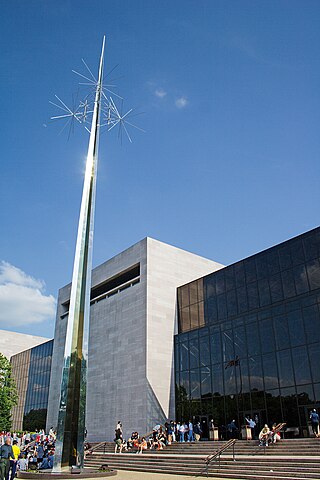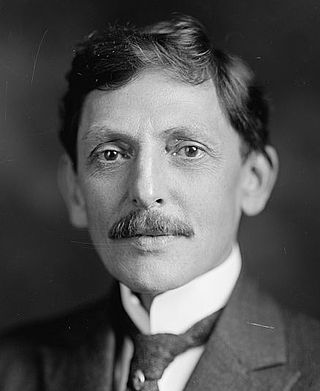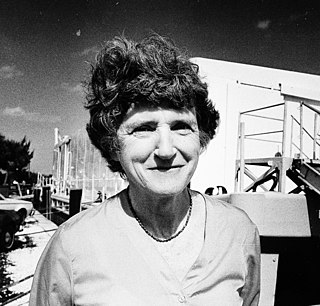Related Research Articles

The National Air and Space Museum of the Smithsonian Institution, also called the Air and Space Museum, is a museum in Washington, D.C., in the United States.

Charles Doolittle Walcott was an American paleontologist, administrator of the Smithsonian Institution from 1907 to 1927, and director of the United States Geological Survey. He is famous for his discovery in 1909 of well-preserved fossils, including some of the oldest soft-part imprints, in the Burgess Shale of British Columbia, Canada.

Spencer Fullerton Baird was an American naturalist, ornithologist, ichthyologist, herpetologist, and museum curator. Baird was the first curator to be named at the Smithsonian Institution. He eventually served as assistant Secretary of the Smithsonian from 1850 to 1878, and as Secretary from 1878 until 1887. He was dedicated to expanding the natural history collections of the Smithsonian which he increased from 6,000 specimens in 1850 to over 2 million by the time of his death. He published over 1,000 works during his lifetime.

The National Portrait Gallery (NPG) is a historic art museum between 7th, 9th, F, and G Streets NW in Washington, D.C., in the United States. Founded in 1962 and opened to the public in 1968, it is part of the Smithsonian Institution. Its collections focus on images of famous Americans. The museum is housed in the historic Old Patent Office Building, as is the Smithsonian American Art Museum.

The National Museum of Natural History is a natural history museum administered by the Smithsonian Institution, located on the National Mall in Washington, D.C., United States. It has free admission and is open 364 days a year. In 2021, with 7.1 million visitors, it was the eighteenth most visited museum in the world and the second most visited natural history museum in the world after the Natural History Museum in London. Opened in 1910, the museum on the National Mall was one of the first Smithsonian buildings constructed exclusively to hold the national collections and research facilities. The main building has an overall area of 1.5 million square feet (140,000 m2) with 325,000 square feet (30,200 m2) of exhibition and public space and houses over 1,000 employees.

Mary Jane Rathbun was an American zoologist who specialized in crustaceans. She worked at the Smithsonian Institution from 1884 until her death. She described more than a thousand new species and subspecies and many higher taxa.

Gerrit Smith Miller Jr., was an American zoologist and botanist.

William Henry Holmes, known as W. H. Holmes, was an American explorer, anthropologist, archaeologist, artist, scientific illustrator, cartographer, mountain climber, geologist and museum curator and director.

Addison Emery Verrill was an American invertebrate zoologist, museum curator and university professor.

Oliver Perry Hay was an American herpetologist, ichthyologist, and paleontologist.

The American Alliance of Museums (AAM), formerly the American Association of Museums, is a non-profit association whose goal is to bring museums together. Founded in 1906, the organization advocates for museums and provides "museum professionals with the resources, knowledge, inspiration, and connections they need to move the field forward."
John Percy Moore (1869–1965) was an American zoologist who specialized in the research of leeches.

Henry Edward Crampton was an American evolutionary biologist and malacologist who specialized in land snails. Crampton undertook the first major study of evolution in nature in his research in the Society Islands. Crampton made twelve separate expeditions over the course of his career to Moorea near Tahiti to study the land snail genus Partula, while years more were spent measuring and cataloguing his specimens. In all, he dedicated nearly half-a-century to the study. Crampton taught as a professor at Columbia University and Barnard College from 1904 to 1943. He also worked as a curator at the American Museum of Natural History.

Smithsonian Libraries and Archives is an institutional archives and library system comprising 21 branch libraries serving the various Smithsonian Institution museums and research centers. The Libraries and Archives serve Smithsonian Institution staff as well as the scholarly community and general public with information and reference support. Its collections number nearly 3 million volumes including 50,000 rare books and manuscripts.

Paul Bartsch was an American malacologist and carcinologist. He was named the last of those belonging to the "Descriptive Age of Malacology".
Tom Day Crouch is an American aeronautics historian and curator.

Marcus Ward Lyon Jr. was an American mammalogist, bacteriologist, and pathologist. He was born into a military family, and demonstrated an early interest in zoology by collecting local wildlife around his father's army posts. He graduated from Brown University in 1897, and continued his studies at George Washington University while working part-time at the United States National Museum (USNM). At the same time, he taught at Howard University Medical School and later George Washington University Medical School. He received his Ph.D. from George Washington University in 1913. In 1919, he and his wife, Martha, moved to South Bend, Indiana to join a newly opened clinic. Prior to moving, Lyon had published many papers on mammalogy, both during and after his tenure at the USNM. In these papers, he had formally described six species, three genera, and one family. Once in South Bend, he began to publish medical studies, too, but continued his work in mammalogy, with a particular focus on the local fauna of Indiana. He published more than 160 papers during his career.

Sophie Lutterlough (1910–2009) was an American entomologist. Lutterlough began working at the Smithsonian National Museum of Natural History (NMNH) as an elevator operator in the 1940s at a time when discriminatory hiring practices prevented African-Americans from working in a curatorial or scientific capacity at the Museum. In the late 1950s, after having gained extensive knowledge of the museum's exhibitions, she asked for and achieved a role in entomological work, eventually restoring hundreds of thousands of insects, classifying thousands. She co-identified 40 type specimens, specimens that stand as the representative example of the species. In 1979, a mite was named in her honor.

Mary Esther Rice was an American invertebrate zoologist specializing in systematics, evolution and the development of marine invertebrates. She worked at the Smithsonian Institution as a curator, educator, research advisor, and administrator from 1966 until her retirement in 2002. She is known for her work on the life histories of Sipuncula, as well as for serving as the first director of the Smithsonian Marine Station at Fort Pierce.

Margaret Brown Klapthor was a curator of the Smithsonian's First Ladies collection and an expert on the history of the White House. She served as chairman of the National Museum of American History's Division of Political History.
References
- 1 2 3 4 A. Gilbert Wright at SIA archives.
- ↑ Taylor FA, Carmichael L (1964). "Report on the United States National Museum". Report of the Secretary and Financial Report of the Executive Committee of the Board of Regents for the Year Ended June 30 1963 (Report). Washington, D.C. pp. 61, 62. Smithsonian Publication 4525 – via Internet Archive.
- ↑ Smithsonian Year 1969 (Report). Washington, D.C.: Smithsonian Institution Press. 1969. p. 505. Smithsonian Publication 4765 – via Internet Archive.
- ↑ Hower RO (1979). "Preface" . Freeze-Drying Biological Specimens. Smithsonian Institution. p. 17. ISBN 0-87474-532-2.